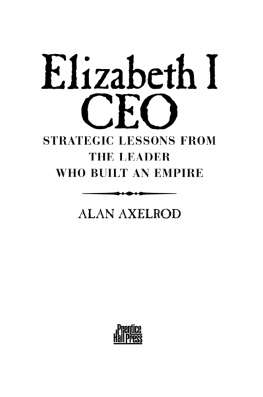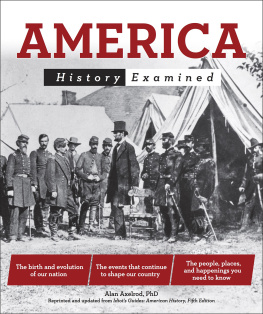Complete Idiots Guide to American History
by Alan Axelrod
Whos on First?
(50,000 B.C.-A.D. 1500S)
In This Chapter
Where the first Americans came from
The Mayas, Incas, and Aztecs
The Anasazi, Mound Builders, and Pueblos
Leif Eriksson, first European in America
Look at a map that shows the north Pacific Ocean. Youll find the Bering Sea, an arm of the Pacific bounded on the east by Alaska, on the south by the Aleutian Islands, and on the west by Siberia and the Kamchatka Peninsula. Near the north end of the Bering Sea is the Bering Strait, which, lying between Alaska and Siberia, connects the Bering Sea with the Chukchi Sea of the Arctic Ocean. At its narrowest, the strait is only 55 miles across, the shortest distance between the continents of North America and Asia. Fifty-five miles in icy cold water is a long swim, but not much of an ocean voyage. Historians believe that once upon a time, there wasnt even that 55 miles of water between the continents.
A Stroll Across the Bering Sea
Several times during what paleontologists call the Quaternary Periodthats their name for the last two million yearsa land bridge emerged in the Bering and Chukchi Seas as the sea level dropped due to the expansion of the ice cap surrounding the North Pole. The theory is that anywhere from 10,000 to 45,000 years ago, human beings used the Bering land bridge to enter the New World, migrating from what is now northeast Asia to northwestern North America. Beringia, as the land bridge is sometimes called, disappeared when the major continental ice sheets and other glaciers melted, causing the sea level to rise again.
45,000 Years of American History (Abridged Version)
The trek across Beringia was not really an evenings stroll. It must have consumed thousands of years. By 9000 B.C., its likely that the former Asians reached Patagonia, at the southern tip of South America. In between, in the area that is the present-day United States, the population of what we now call Native Americans may have reached 11 million.
These Native Americans, thinly distributed over a vast area in bands of a hundred or even fewer individuals, lived for thousands of years on the ragged edge of subsistence. They didnt develop great cities, but, as nomads, wandered, hunted, and foraged together. Then, perhaps 9,000 years ago, some bands began to domesticate plants in order to supplement foraged and hunted food. By the beginning of the 16th century, when Europeans first made contact with Native Americans, they were cultivating maize, beans, and squash, as well as manioc, potatoes, and grains.
Agriculture fostered a more stable lifestyle than hunting and gathering, and the horticultural groups lived in tribes. Along with relatively stable sources of sustenance and substantial populations came more or less permanent houses organized into villages, usually led by a recognized chief.
Living at a subsistence level, its not surprising that, within the area of the United States, the Native Americans left little material evidence of their ancient cultures. In the Southwest, archaeologists have identified a people they call the Anasazi (from a Navajo word meaning the ancient ones). The Anasazi appeared as early as 5500 B.C. and are also called the Basket Makers, because of the many skillfully woven baskets that have been discovered in sites associated with their culture. The Anasazi built communal dwellings consisting of wood and thatch, and even occupied shallow caves closed off with rocks. By A.D. 400-700, Anasazi communities evolved into collections of somewhat more sophisticated pit houses, built over shallow excavations. During the period of A.D. 700-1100, the Anasazi began building what Spanish invaders would later call pueblos (Spanish for town or village and also people). These were fantastic groupings of stone and adobe apartment buildings, cliff dwellings seemingly hewn out of lofty ledges, the most spectacular of which survive at Mesa Verde in southwest Colorado.
In the meantime, to the east, in a vast area stretching from the Appalachian Mountains to the eastern, edge of the prairies, and from the Great Lakes to the Gulf of Mexico, other Native Americans were building cultural monuments of a different kind. From about 1000 B.C. to after A.D. 1500, many different Indian societies constructed earthworks that modern archaeologists classify as burial mounds, platform or temple mounds (which served as the foundations for important public and private buildings), and circular and geometric ceremonial earthworks. Archaeologists further recognize two traditions among the mound-building cultures: the Woodland and the Mississippian.
The Woodland mounds were built in eastern North America from about 1000 B.C. to the beginning of the 18th century. The earliest were simple, enclosing only a few burials, but later mounds often reached 80 feet in height, took many years to construct, contained numerous burials, and even included log tombs. The largest and most elaborate of the mounds was built in southern Ohio by people of the Hopewell culture (named after mounds found near the Ohio hamlet of Hopewell).
The mounds of the Mississippian tradition reflect the development of larger-scale farming among the Native Americans. Beginning around A.D. 700, in the flood plains of the central and lower Mississippi River, various tribes built villages consisting of palisades and flat-topped, rectangular mounds that served as bases for temples and other important structures. The Cahokia Mounds, which are found in Illinois, just across the Mississippi from Saint Louis, must have once contained as many as 50 platform mounds and probably supported a population numbering in the thousands.
Pueblos, mounds, some baskets, a few potsthese are the chief material remains of Native American culture before Europeans set foot in what is today the United States. But, to the south, in present-day Mexico and Central and South America, Native American civilization took a very different turn.
The Maya lived in southern Mexico and in Belize, Guatemala, and adjacent Honduras. In contrast to the Native Americans, the Maya kept written historical records, extending back to 50 B.C. and ending with the Spanish conquest in the 16th century.
By 5000 B.C., the Maya were installed along the Caribbean and Pacific coasts. Within the next 3,000 years, they began to move inland, turning from fishing to agriculture. By about 1,200 B.C., another Native people, the Olmec of the Gulf Coast, dominated trade in Central America and began greatly influencing Mayan culture. By 1000 B.C., the Maya adopted Olmec styles of pottery and jades and also took on Olmec religious symbols. Maya culture and power reached its height by A.D. 900, when it seems to have collapsed, probably due to famine, disease, and chronic warfare among Maya city-states. A landscape adorned with spectacular stepped-pyramid temples and other structures endured, and various Mayan groups continued to prosper in varying degrees until the 16th century, when the Spanish conquistadors invaded.
Most of what is today called Mexico fell under the domination of another great Native American civilization, the Aztecs. Their own myths place their origin at Aztlan, somewhere in north or northwest Mexico, where they lived as a small, nomadic collection of tribes.
During the 12th century A.D., the Aztec tribes migrated southward, settling in the central basin of Mexico by the 13th century. Their existence was a precarious one, as they were repeatedly attacked and routed by other groups. Finally, the Aztecs took refuge on small islands in Lake Texcoco where, in 1325, they founded Tenochtitlan on the site of present-day Mexico City.











